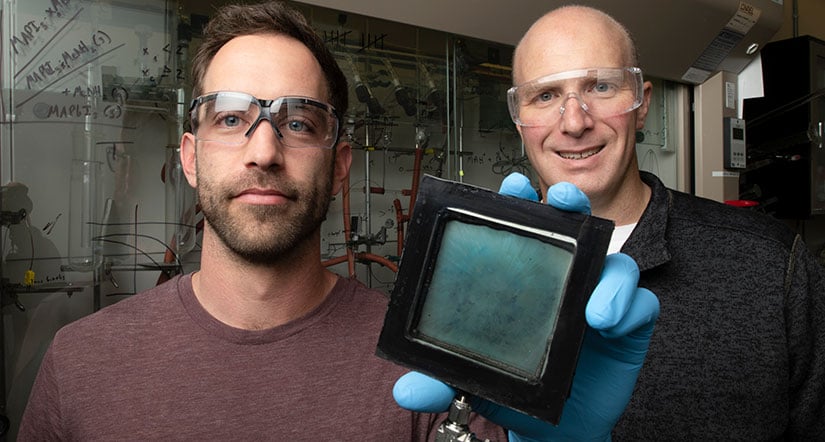Windows Research
For more than 35 years, NLR scientists have pioneered the evaluation, development, and demonstration of advanced fenestration research.

NLR researchers Lance Wheeler and Robert Tenent are developing SwitchGlaze window into a working prototype. When sunlight hits the glass, the window darkens and generates electricity. Photo by Dennis Schroeder, NLR
Openings in a building’s envelope, called fenestration, include windows, curtain walls, skylights, and doors. They are critical to building performance and occupant comfort.
Windows are responsible for about 10% of energy use in buildings and influence end uses that compose 40% of building energy use.
Working closely with industry partners, NLR focuses on emerging fenestration concepts and supports development of standards that benefit the industry. This research includes building energy modeling, economic analysis, materials development, protype demonstration, durability assessment, and field demonstration.
Durability Evaluation
Energy savings and carbon emission reductions are only delivered if new products have sustained, long-term performance. NLR provides the scientific and engineering basis to develop new and appropriate industry standard methods for durability evaluation of emerging, high-performance products. Then transferring that knowledge to the private sector encourages deployment of new, energy-efficient products that build consumer and market confidence. NLR collaborates with industry partners on various emerging fenestration technologies including vacuum insulating glass, dynamic glass, aerogels, and photovoltaic windows. In addition, NLR is working with multiple partners and industry standards bodies to improve durability assessment methods for present market technologies.
Impact: With QAI Laboratories, NLR worked with industry to develop a path toward certification of the durability of dynamic glazings, using the ASTM E2141/E2953 methods (Standard Test Method for Accelerated Aging of Electrochromic Devices) that NLR developed earlier. Industry standards build confidence in new, high-performance products.
Partners: Department of Energy's Building Technologies Office, QAI Laboratories, and multiple fenestration developers and manufacturers
Electrochromic Windows
Developed over three decades of NLR research, electrochromic windows are installed in buildings across the country. They provide an adjustable tint that allows occupants and building mangers to control the sunlight entering a building, helping to keep it warmer in the winter and cooler in the summer. Cheaper electricity bills, more privacy, and a better view are key benefits of electrochromic windows.
Impact: A standard used by industry, ASTM E-2141 (Standard Test Method for Accelerated Aging of Electrochromic Devices), was developed and are offered by NLR. This important evaluation method is being transitioned to private laboratories.
Partners: SageGlass, QAI Laboratories, Wells Fargo Innovation Incubator
Photovoltaic Windows
NLR pioneered the development of combined thermochromic-photovoltaic windows capable of converting sunlight into electricity at a high efficiency. Called SwitchGlazeTM, the technology relies on materials called perovskites, which are highly efficient at converting sunlight to electricity. The new technology responds to heat by transforming from transparent to tinted. As the window darkens, it generates electricity while simultaneously reducing glare and unwanted heating loads. This carries a dual benefit of improved energy efficiency with additional energy generation.
Impact: SwitchGlaze is improving the functionality of smart windows by combining dynamic window functionality with solar generation.
Partners: Department of Energy's Building Technologies Office
Contact
Share
Last Updated Dec. 6, 2025
